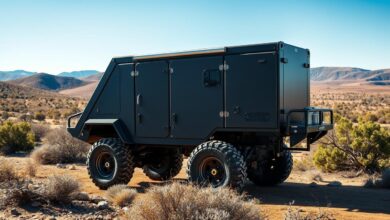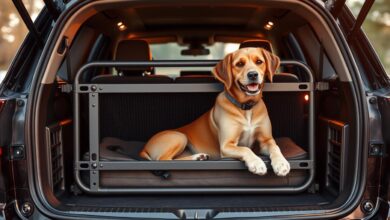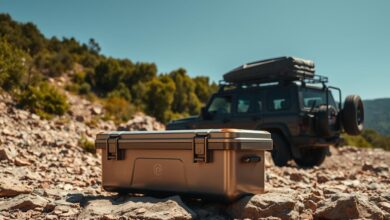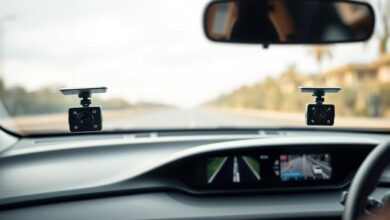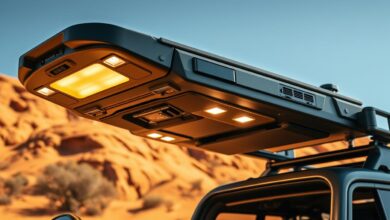The Ultimate Guide to Choosing the Right UHF Radio
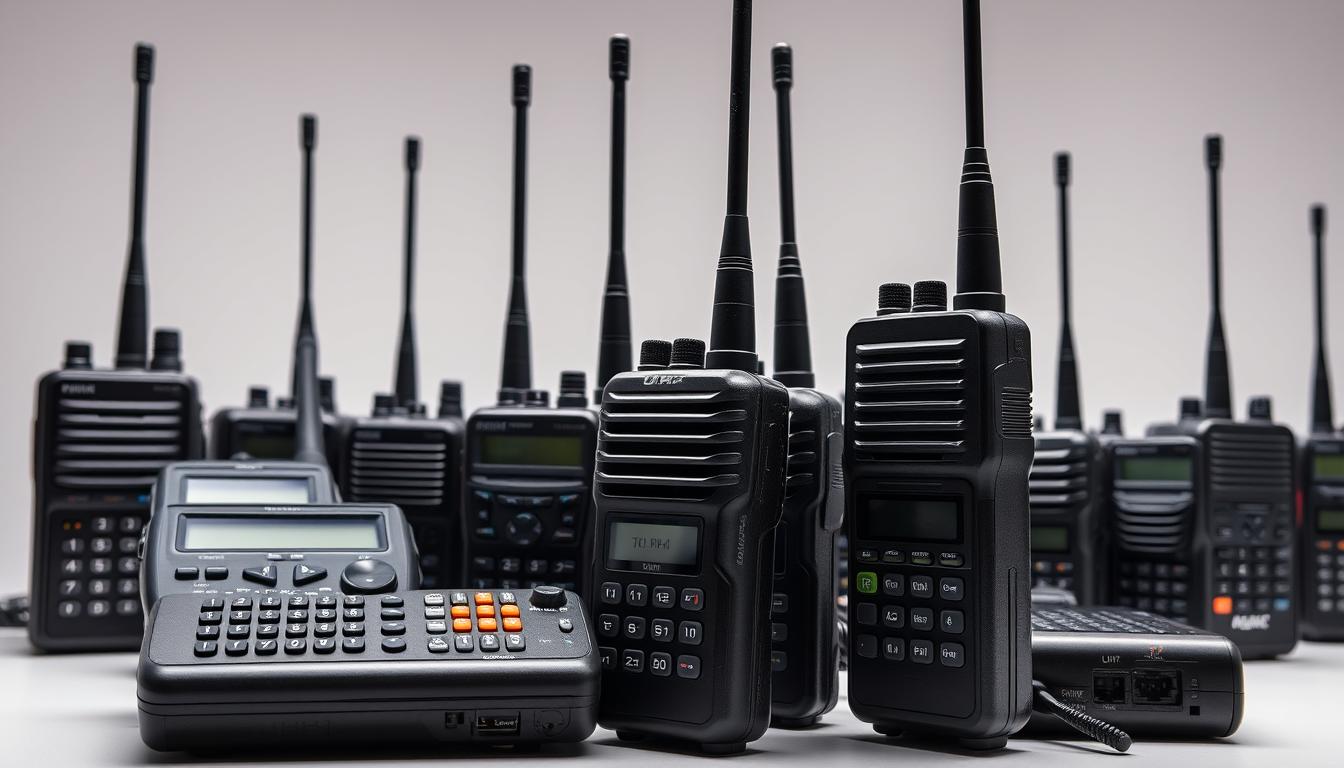
Finding the right UHF radio can be tough, with so many choices out there. Whether you love the outdoors or need a reliable way to talk, picking the best one is key.
You want a radio that fits your needs perfectly. With our help, you can make a smart choice. Our guide will show you what to look for in a UHF radio. This way, you can stay in touch and stay safe.
Key Takeaways
- Understand your specific needs for a UHF radio.
- Consider the frequency range and compatibility.
- Look for durability and water resistance.
- Evaluate the battery life and charging options.
- Assess additional features like GPS and emergency alerts.
Understanding UHF Radio Basics
Before picking a UHF radio, it’s key to know the basics of UHF tech. UHF radios use ultra-high frequency bands for clear talk, even where phones can’t reach. They come in handheld and fixed versions, fitting different needs.
What is UHF Radio?
UHF radio is a two-way device that uses the ultra-high frequency band, from 403 MHz to 470 MHz. This range helps talk through many terrains and weather. UHF radios can get through walls and hills, making them great for work and play.
How UHF Radio Works
UHF radios send and receive signals on certain frequencies. When you press the talk button, your voice turns into a signal sent to other radios on the same frequency. The receiving radios turn the signal back into sound, letting you talk in real-time. The quality of your radio and the environment affect how well it works.
“The right UHF radio can be a game-changer in emergency situations or during outdoor adventures.”
Benefits of Using UHF Radios
UHF radios are great for staying in touch where phones can’t reach. They’re also flexible, with choices from small handhelds to big fixed units. They boost safety and teamwork, whether for work or adventure.
- Reliable communication in remote or challenging environments
- Versatility with various form factors available
- Enhanced safety and coordination for teams and individuals
Knowing these basics helps you choose the right UHF radio for you.
Key Factors to Consider When Choosing UHF Radios
Choosing the right UHF radio is important. It should meet your specific needs. Whether for fun, work, or emergencies, the right radio makes a big difference.
Frequency Range and Channels
The frequency range and channels are key. UHF radios use frequencies between 403 MHz and 470 MHz in Australia. You need to think about how many channels you need.
For example, if you’re part of a big group, you’ll need more channels. This is for different sub-groups or functions.
To learn more about choosing the right UHF setup, check out GME’s guide on UHF setups.
| Frequency Range | Typical Use |
|---|---|
| 403-470 MHz | General UHF communication, suitable for most users. |
| Specific channels within the range | Reserved for specific industries or emergency services. |
Power Output Considerations
The power output affects how far your radio can send signals. More power means longer range. But, you also need to think about battery life and legal limits.
In Australia, radios can’t have more than 5 watts of power.
Power Output Guidelines:
- Low Power (0.5W): Good for short distances, perfect for casual use.
- Medium Power (2W-3W): A good balance between range and battery life, great for most uses.
- High Power (5W): Offers the longest range, best for critical or challenging situations.
Battery Life and Type
Battery life is very important, mainly for handheld radios. The battery type and size affect how long you can use it. Rechargeable batteries are cheaper and better for the environment.
“The right battery can make all the difference in your UHF radio experience, providing reliable power when you need it most.”
Think about how you’ll use your radio and choose a battery that fits your needs. Some radios also let you use disposable batteries, which can be handy in some situations.
Different Types of UHF Radios Available
UHF radios come in various forms, including handheld, mobile, and base station models. Each type meets different user needs. It’s important to understand these types to choose the right device for you.
Handheld UHF Radios
Handheld UHF radios are small, portable devices. They are great for personal use, outdoor activities, or when you need to move around. These radios are light and easy to carry, fitting in a pocket or on a belt.
Key Features: Compact design, battery-powered, easy to use.
Mobile UHF Radios
Mobile UHF radios are for use in vehicles. They offer reliable communication on the move. Installed in cars, trucks, and other mobile equipment, they have more power than handhelds for a longer range.
For more information on mobile UHF radios and their applications, you can visit this guide.
Base Station UHF Radios
Base station UHF radios are fixed devices for use in a stationary location. They are often found in homes, offices, or command centers. These radios have more advanced features and better reception than handheld or mobile radios.
Advantages: Higher power output, advanced features, and better reception.
When picking a UHF radio, think about what you need. Whether it’s a portable handheld, a mobile radio for your vehicle, or a fixed base station, there’s a UHF radio for you.
UHF Radio Features that Matter
To get the most out of your UHF radio, it’s important to know what features are key. When shopping for a UHF radio, certain features can greatly improve your experience. These features affect how well the radio works, how long it lasts, and how easy it is to use.
Weather Resistance and Durability
A UHF radio needs to handle tough weather if you’ll use it outside. Look for radios with a IP67 or higher rating. This means they’re dustproof and can handle being underwater. Also, a strong build helps protect your radio from drops and rough use.
Sound Quality and Clarity
Good sound quality is key for clear communication. UHF radios with noise-cancelling technology improve sound by cutting out background noise. Also, adjustable volume controls are handy for different settings.
Programmability and Customization
Being able to program and customize your UHF radio makes it more useful. Look for radios that let you customize channels, tone codes, and settings to meet your needs. Customization can also include setting up special modes for emergencies.
| Feature | Importance | Benefit |
|---|---|---|
| Weather Resistance | High | Protects the radio from harsh conditions |
| Sound Quality | High | Ensures clear communication |
| Programmability | Medium | Allows customization for specific needs |
By focusing on these important features, you can find a UHF radio that fits your needs. Whether for fun or work, the right features can really improve your experience.
How to Choose the Right Antenna
Choosing the right antenna for your UHF radio is key for the best performance. The antenna is important for sending and getting signals. This affects how well your radio works.
Types of Antennas for UHF Radios
There are many antennas for UHF radios, each for different needs and places. The main types are:
- Rubber duck antennas: Flexible and small, great for handheld UHF radios.
- Stubby antennas: Short and small, used for mobile UHF radios where space is tight.
- External antennas: Bigger and stronger, for base station UHF radios to reach further.
- Directional antennas: Focuses signal in one direction, improving performance there.
For more on choosing antennas, check out Radioddity’s Guide to Select Antennas.
Antenna Gain and Performance
Antenna gain is very important for your UHF radio’s performance. It’s measured in decibels (dB). A higher gain means better signal focus and longer range, but the antenna might be bigger and less all-around.
| Antenna Type | Gain (dB) | Typical Use |
|---|---|---|
| Rubber Duck | 0-3 dB | Handheld UHF Radios |
| Stubby | 2-5 dB | Mobile UHF Radios |
| External | 6-10 dB | Base Station UHF Radios |
| Directional | 10-15 dB | Long-range Communication |
Installation Tips for Antennas
Installing your antenna right is key for the best performance. Here are some tips to get the most from your UHF radio antenna:
- Place the antenna straight up to get the strongest signal.
- Don’t put the antenna near metal or other interference.
- For external antennas, make sure they’re securely mounted to handle the weather.
- Check the antenna often for damage or wear and replace it if needed.
Knowing about different antennas, their gain, and how to install them can really boost your UHF radio’s performance and dependability.
Understanding Licensing and Regulations
Using UHF radios means you need to know about licenses and rules. These rules cover things like frequency bands and who you need to follow. It’s all about making sure you’re allowed to use your radio and can talk to others without problems.
Do You Need a License for UHF Radios?
Whether you need a license depends on your UHF radio service. For example, GMRS (General Mobile Radio Service) needs a license from the FCC. But FRS (Family Radio Service) does not. Knowing the difference helps you figure out if you need a license.
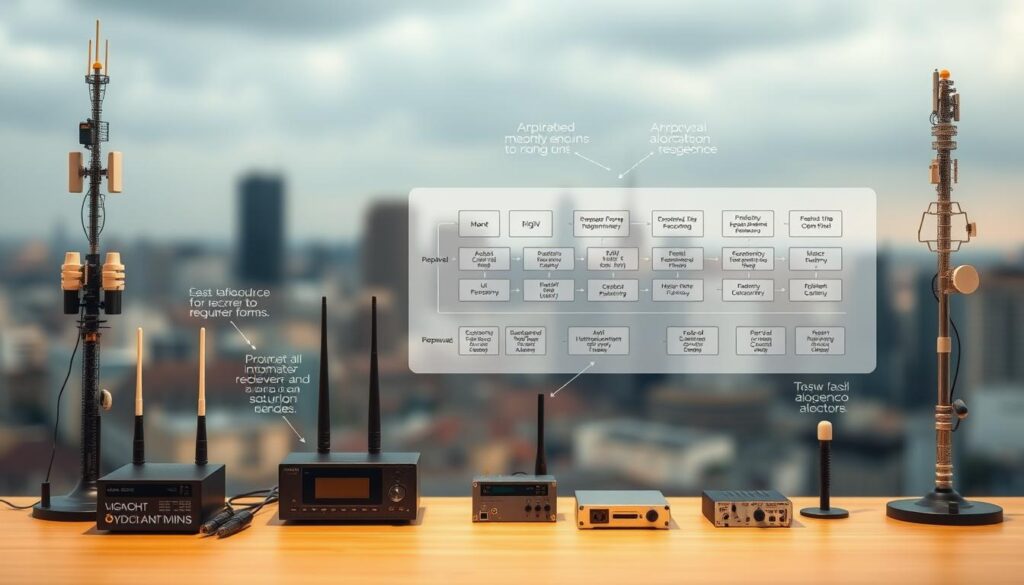
FCC Regulations and Compliance
The FCC (Federal Communications Commission) controls UHF radios in the US. You must follow FCC rules. This means sticking to certain frequencies, power levels, and how you use your radio. Following these rules helps you avoid fines and keeps your communication clear.
Understanding GMRS vs. FRS vs. MURS
GMRS, FRS, and MURS are different radio services. GMRS is licensed and has more power, great for work and personal use. FRS is not licensed but has less power, good for short talks. MURS is also not licensed but has specific frequencies for work and personal chats. Knowing these differences helps you pick the right UHF radio for you.
| Service | License Requirement | Power Limit | Typical Use |
|---|---|---|---|
| GMRS | Yes | Higher | Business, Personal |
| FRS | No | Lower | Short-range |
| MURS | No | Specific | Personal, Business |
Knowing about UHF radio licenses and rules helps you use your radio right. Whether it’s GMRS, FRS, or MURS, picking the right one is key for your needs.
UHF Radio Accessories to Enhance Your Experience
Getting the most out of your UHF radio is easy with the right accessories. Whether you use it for fun or work, the right gear can make a big difference.
Headsets and Earpieces
A good headset or earpiece is a must-have for UHF radios. They let you talk privately, cutting down on background noise. This means you can hear messages clearly, even in loud places. Some top picks include:
- Noise-cancelling headsets for better sound
- Earpieces with microphones for easy hands-free use
- Comfortable headsets for long wear
Chargers and Battery Packs
Having extra chargers and batteries is key to keeping your UHF radio going. Spare batteries are a must for long use or when power is scarce. Look for:
- Quick chargers to top up batteries fast
- Big battery packs for longer use
- Car chargers for charging on the move
Carrying Cases and Mounts
It’s important to protect your UHF radio and accessories, even when you’re moving around. Cases and mounts keep your gear safe and organized. You can find:
- Tough cases for protection from the weather
- Vehicle mounts for secure in-car or boat use
- Belt clips and holsters for quick access
Choosing the right accessories boosts your UHF radio’s function and convenience. This means better communication for you.
Common Use Cases for UHF Radios
UHF radios are great for both fun activities and work. They are reliable and versatile, making them essential in many areas.
Recreational Use
Outdoor lovers like hiking, camping, or skiing find UHF radios handy. They help keep groups connected when cell phones don’t work.
Popular recreational uses include:
- Hiking and trekking
- Camping and outdoor adventures
- Skiing and snowboarding
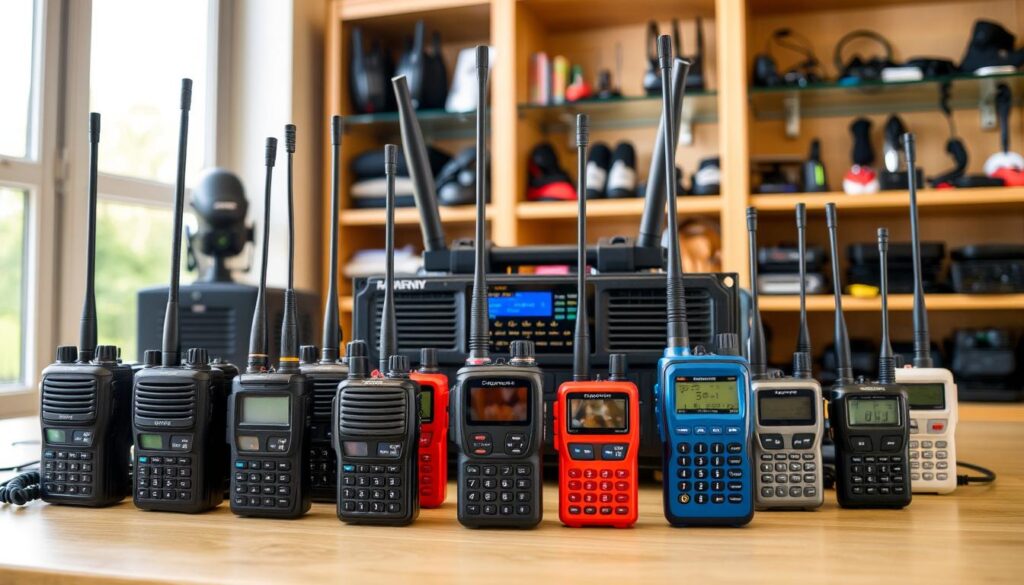
Professional and Industrial Applications
At work, UHF radios help teams talk clearly. They’re key in construction, manufacturing, and logistics.
| Industry | Use Case | Benefits |
|---|---|---|
| Construction | Site communication | Enhanced coordination, improved safety |
| Manufacturing | Production line communication | Increased efficiency, reduced downtime |
| Logistics | Warehouse and transportation coordination | Better inventory management, faster response times |
Emergency Communication Scenarios
In emergencies, UHF radios are vital. They help firefighters and paramedics work together and keep people safe.
Reliable communication is key in emergencies, and UHF radios deliver.
Comparing Popular UHF Radio Brands
The UHF radio market is full of choices, with Kenwood, Motorola Solutions, and Yaesu at the top. Knowing what each brand offers can help you pick the right UHF radio.
Kenwood UHF Radios
Kenwood is known for making top-notch UHF radios. They focus on durability and function, making them great for fun and work. Kenwood UHF radios come with cool features like programmable keys and tough builds.
Motorola Solutions UHF Radios
Motorola Solutions is a big name in UHF radios. They make reliable devices for work and industry. Their radios are loved for clear sound and long battery life.
Yaesu UHF Radios
Yaesu is famous for its high-performance UHF radios. They’re a hit with both hobbyists and professionals. Yaesu radios stand out for their versatility and cool features, like advanced filters and wideband reception.
When picking a UHF radio, think about what you need. Whether it’s for fun, work, or emergencies, knowing what each brand offers is key.
Maintenance and Care for Your UHF Radio
Keeping your UHF radio in good shape is key to its long life and top performance. Regular care stops problems and keeps sound quality high. This way, you can count on clear communication, whether for fun or work.
Routine Checks and Troubleshooting
Look over your UHF radio often for signs of wear. Check the antenna, battery contacts, and the outer casing for damage. If sound is bad or it won’t send signals, try adjusting settings or swapping the battery.
Cleaning and Storage Tips
Wipe your UHF radio with a soft cloth and avoid strong cleaners. Store it in a dry, cool spot, out of the sun. Take out the battery when not using it to stop rust.
Updating Software and Firmware
Make sure your UHF radio has the latest software and firmware. These updates can boost performance, add new features, and make it work better with other gadgets. Visit the maker’s website for updates and follow their guide to install them.
FAQ
What is the ideal frequency range for a UHF radio?
The best frequency range for a UHF radio varies based on your needs. UHF radios usually work between 403 MHz and 470 MHz. Choose a frequency that fits your use, like the 70cm band (420-450 MHz) for amateur radio.
How do I choose the right power output for my UHF radio?
The power output of your UHF radio depends on how far you need to talk and the terrain. For short distances in cities, a lower power (1-2 watts) is enough. But for longer ranges or rural areas, you might need more power (up to 5 watts or more).
What is the difference between handheld, mobile, and base station UHF radios?
Handheld UHF radios are easy to carry and good for personal use. Mobile UHF radios fit in cars and have more power. Base station UHF radios are fixed and have the most power, great for work or business.
Do I need a license to operate a UHF radio in Australia?
In Australia, you might need a license for a UHF radio, depending on the frequency and service type. UHF CB radios on the 477 MHz band don’t need a license. But other bands might require a license from the Australian Communications and Media Authority (ACMA).
What are the benefits of using a UHF radio with weather resistance and durability?
A weather-resistant UHF radio can handle tough conditions like water, dust, or extreme temperatures. This ensures you can communicate reliably, even in harsh environments.
How do I maintain and care for my UHF radio?
To keep your UHF radio in top shape, do regular checks and clean it often. Store it in a dry, cool place. Also, update the software and firmware to keep it working well.
What are the advantages of using a UHF radio with programmability and customization?
A programmable UHF radio lets you customize it for your needs. You can set up custom channels, adjust tones, or configure it for specific uses. This makes your experience better.
Can I use a UHF radio for emergency communication scenarios?
Yes, UHF radios are great for emergencies like search and rescue. They’re reliable, have good range, and work well in tough conditions.
What are the key differences between popular UHF radio brands like Kenwood, Motorola, and Yaesu?
Kenwood is known for high-quality handheld radios. Motorola offers strong, feature-rich mobile radios. Yaesu is popular among amateur radio fans for its wide range of models and advanced features.
How do I choose the right antenna for my UHF radio?
When picking an antenna, think about the frequency range, gain, and type (directional or omnidirectional). Also, consider the installation needs and make sure it fits your UHF radio model.

